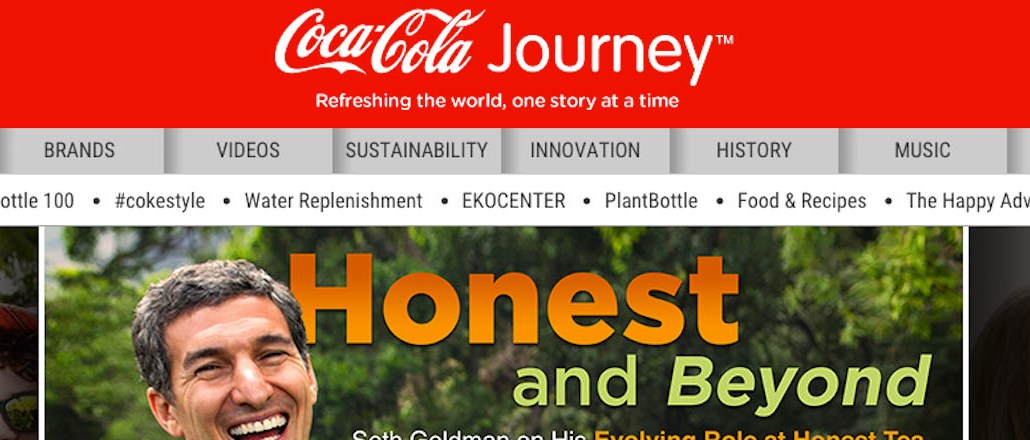
Coke has for years tried to establish itself as a brand publisher. And just like publishers before it, it is feeling the pressure from social platforms.
The big one is Facebook. Coke’s “Journey,” the branded content news site that it replaced its corporate website with three years ago, has also felt the pinch from declining organic reach and traffic. (Referral traffic to top publishers has fallen 32 percent so far this year, Digiday recently reported.) Organic isn’t getting Coke the publisher very far either, so Doug Busk, who heads digital and social media communications at the brand has moved to more paid traffic. He said his team is appreciative of the “fairly affordable” paid mechanisms the platform has come up with. “They have more than made up for a challenging environment for brand publishers.”
On Journey, which is staffed by about a dozen reports and editors, articles run from straight corporate news (a new bottle) to health and wellness articles that don’t even mention the brand.
The brand said the site has contributed up to 50 percent of the social media growth for Coke the brand in the last three years. But metrics and data are shifting for publishers, so the brand has created its own formula for measuring ROI on articles. Coke calls it “expressions of interest,” or EOI — it’s a combination of traditional metrics including pageviews, bounce rates, read rates, time spent, sharing and commenting. The formula also tries to cut out repeat posts or engagement stemming purely from Coke’s enormous social media presence. “If we don’t change the conversation or inform readers, we’re not doing our job, and the metric to measure that is EOI.”
The brand is also looking into options to go beyond Facebook’s declining reach. One of them: publishing on platforms. Busk said he is closely watching “alternative publishing environments” like Apple News, Pocket — the save and read apps — and even Facebook’s Instant Articles. The feature is so far only open to traditional publishers, but when asked about brands like Coca-Cola publishing there, Busk demurs, saying, “All I can say is, ‘watch this space.’”
“We’re on a verge of what I find is a renaissance of publishing and publishers,” he said. “We’re going to filter against where can deliver the best quality experience for readers, so if we can’t deliver a quality experience, then we won’t get on it.”
Facebook has so far only opened Instant Articles up to a small group of publishers. But brands with strong journalism presences like GE are also definitely interested. But publishers that are on Instant Articles, like Buzzfeed, are not allowed to post sponsored content.
Today, there are 18 Coke markets with their versions of Coca-Cola Journey, and Busk has plans to double that in the next year. Journey has a handful of staffers and editors and a mix of content about culture, innovation, sustainability and the like. Branding in the articles runs the gamut, with some carrying no brand mentions to the other end of the extreme, such as one looking back at the “iconic” Coke bottle. And the rise of social platforms has also changed how Busk’s team operates. There is much more noise on social media, both from brands and publishers (and brands as publishers) so Busk said that the only thing that has worked is a cautious, wait-and-see approach.
That explains Journey’s relatively late entry to Instagram. About six months ago, it launched @thecocacolaco, a corporate Instagram handle. “We waited until we had a smart, high-quality play to make,” he said.
A temptation would be to post pictures of Coke contour bottles (as other brands have found, simpler images like an AmEx card or pictures of vodka bottles work best), but Busk said he wants to stay away from that. “Our challenge now is photography that does at least as well as the Coke bottle on Instagram.” It’s not quite there yet: The handle has under 3,000 followers. (In comparison, Coke has almost a million followers on Facebook, just under 800,000 on LinkedIn, and almost 400,000 on Twitter.)

There have been other social strategy changes. When Journey began, every post on social media sent readers back to the Journey site. Over time, the brand has tried to promote stories on the platform they’d be most suited for instead of a spray-and-pray approach.
Take the current most popular article on Journey, an interview with the CEO of Coke-owned Honest Tea, Seth Goldman, about his plans and career. It got a paltry 16 likes on Facebook — but almost 1,000 on LinkedIn.
That is a “fine example” of why content curation matters, said Busk. “We would view that as a success, and it’s rewarding because we correctly guessed that LinkedIn would be the place for it. Our challenge now is to continue telling compelling stories about who we are and what we do in a way that keeps up with our readers,” said Busk.
Homepage image courtesy of Coke.
More in Marketing

Zero-click search is changing how small brands show up online — and spend
To appease the AI powers that be, brands are prioritizing things like blogs, brand content and landing pages.

More creators, less money: Creator economy expansion leaves mid-tier creators behind
As brands get pickier and budgets tighten, mid-tier creators are finding fewer deals in the booming influencer economy.

‘Still not a top tier ad platform’: Advertisers on Linda Yaccarino’s departure as CEO of X
Linda Yaccarino — the CEO who was never really in charge.





